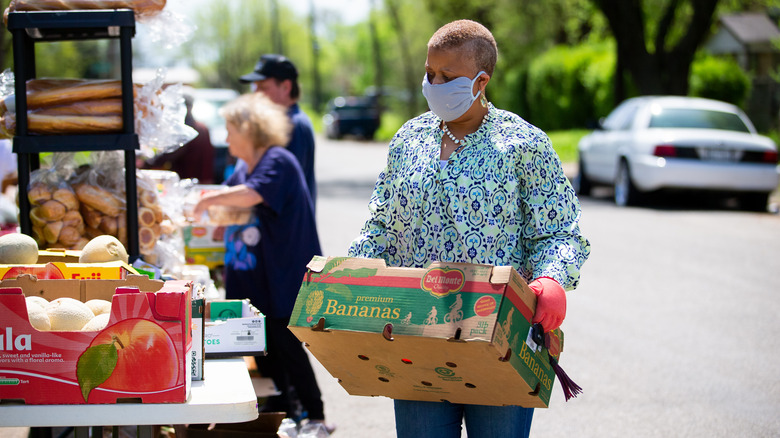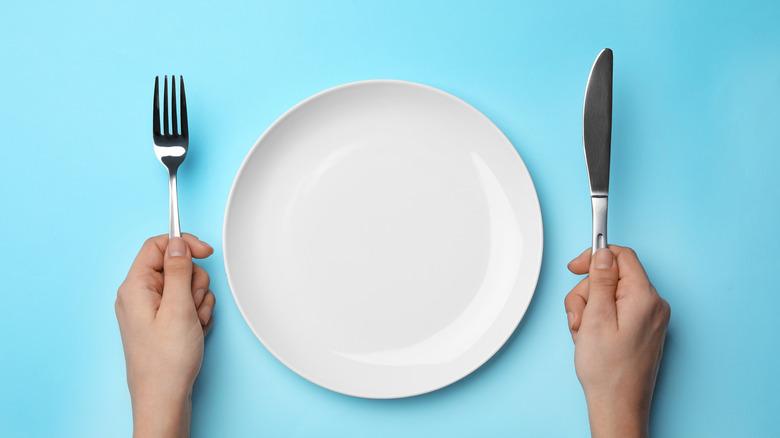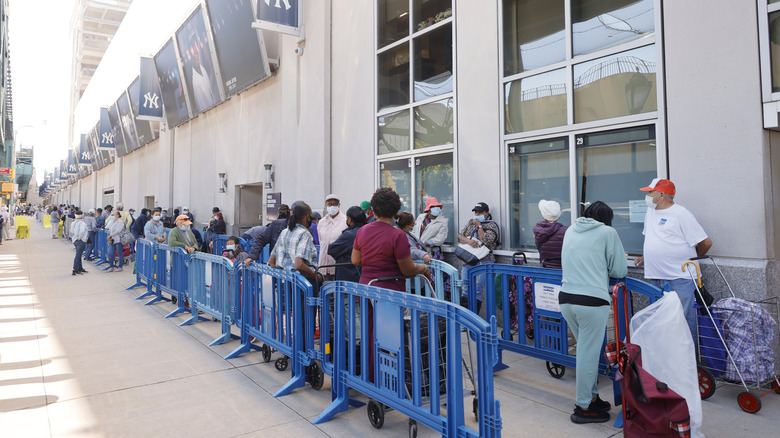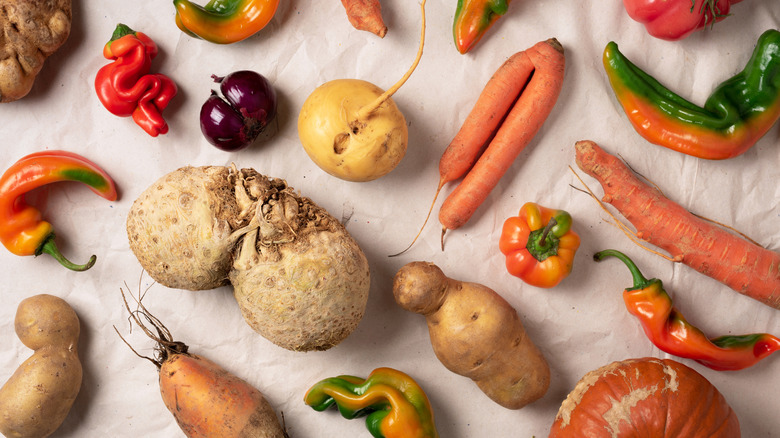Food Insecurity In The US Shows More Adults Are Not Getting Recommended Nutrition
Despite the fact the United States has the world's largest economy, food insecurity affects more than a tenth of its people, according to the USDA. Many Americans are simply not getting the amount of food they need.
On top of food insecurity, Americans face a unique issue — many are getting enough calories, but not enough nutrients, leading to long-term health issues. Simply put, the highly-processed foods we eat are devoid of essential nutrients. Several factors contribute to this problem, and some populations are more at risk than others. Non-profits and government organizations across the nation are attempting to combat the issue, but there are also things that everyday Americans can do to help combat food inequity. So, what exactly is food insecurity, and what is causing these issues? Here we'll take an in-depth look at the meaning of food insecurity, the factors contributing to it, and the potential solutions.
What is food insecurity?
According to the United States Department of Agriculture (USDA), the term food insecurity can describe a range of situations. As a result, in 2006, the U.S. Government created different categories for levels of food security.
They break food security down into two categories. High food security involves "no reported indications of food-access problems or limitations." That slips to marginal food security, which is defined when someone reports having anxiety over access to food or the amount of food in their house once or twice. People in the marginal category do not usually have an impacted diet.
Food insecurity occurs when someone's access to food impacts their diet. When someone has a "reduced quality, variety, or desirability of diet," they have low food security. When an individual has "multiple indications of disrupted eating patterns and reduced food intake," their food security is categorized as very low. The USDA also makes a distinct definition of hunger, describing the condition as "an individual-level physiological condition that may result from food insecurity."
Millions of Americans are going hungry
According to the USDA, 38 million Americans faced food insecurity in 2020, including 12 million children. The coronavirus pandemic only exacerbated the problem, driving up food bank use by 55% at its peak, according to Feeding America.
Although food insecurity can affect anyone, certain populations are more vulnerable than others. This includes people in rural communities, elderly Americans, and Black and Latin Americans. The Food Research and Action Center says that in 2020 Black Americans were three times more likely to be food insecure than white Americans, while Latin Americans were twice as likely. People in the south and midwest are also more likely to be food insecure, with western and northeastern states being the most food secure. Rural households were more likely to suffer from food insecurity than people living in metropolitan areas — 11.6% compared to 10.4%. Households with children are almost twice as likely to be food insecure than those without. However, the USDA reports that adults are usually the members of food insecure households bearing the brunt of the issue, while children are "protected from substantial reductions in food intake even in households with very low food security."
Working families can experience food insecurity
Although unemployed individuals face higher rates of food insecurity, having a steady job does not guarantee you will have enough to eat. According to the president of Feeding America, who recently spoke to NPR, many working Americans use the resources available, such as food banks, pantries, and mutual aid organizations. There are other reports of people who were previously employed but lost jobs during the pandemic and now rely on food donations. Higher living costs mean more people are reliant on food banks, and food banks are struggling to meet demands as their costs have increased too.
Despite the recent pressures, working families requiring help from food pantries isn't a recent problem. As far back as 2014, Oxfam reported that over half of the households seeking assistance from Feeding America had at least one adult employed within 12 months of contacting the charity. Retirees on fixed incomes have also been flocking to food pantries after seeing costs increase in recent years (via The Washington Post). As the data shows, food insecurity is a problem that extends throughout society, no matter whether you are gainfully employed or not.
The quality of food is also a problem
Food insecurity isn't just related to calorie intake. In many cases, people are consuming enough calories but not getting the proper nutrients. The CDC suggests that both income and access play a part in some Americans' lack of nutritious, healthy foods. Fruits and vegetables are typically more expensive than junk food, fueling the issue, with organic fruits and vegetables coming with an even higher premium. Then there is the issue of food deserts — populated areas that lack well-stocked grocery stores with a wide array of healthy produce. People living in low-income urban areas, rural areas, and tribal lands are less likely to have access to affordable, nutritious food.
Although several programs, such as Racial and Ethnic Approaches to Community Health (REACH), are attempting to "end health gaps" by improving disadvantaged communities' access to cheap, nutritious food — diet-related illness remains a major public health issue in the United States. Diets rich in sodium, saturated fat, and sugar drastically lower life expectancy and increase the risk of developing a serious long-term illness. Nine in 10 Americans consume more than the CDC's recommended amount of sodium. Nutritional deficits are also a significant problem, with one in six pregnant women having too little iron.
Diet-related illness is a killer
Studies have shown a poor diet is more of a factor in global deaths than tobacco usage and high blood pressure. A high sodium diet, in particular, has been repeatedly flagged as a health risk. The CDC also claims that 70% of the average American's sodium intake comes from pre-packaged, store-bought, or restaurant foods. They say diseases like heart disease, stroke, and Type 2 diabetes, several cancers, can be caused by poor diet.
A Harvard University study has shown that $50 billion a year is spent on diet-related healthcare costs in the United States alone — accounting for 20% of American healthcare spending. Again, the source of the diseases was flagged as a high intake of foods with low nutritional value and a deficit of foods high in essential nutrients. Beyond the more severe conditions, a poor diet can also cause minor ailments, like skin, hair, and nail problems (via SFGate).
Cheaper fruit and vegetables are available
One of the key factors in nutritional deficit is a lack of accessible and affordable produce. Fruits and vegetables tend to cost more than processed foods. Even if a household can afford to buy them, they may have to go out of their way to find a store that stocks a good variety if they live in an area that could be considered a food desert. Fortunately, some options may help these households, including "ugly" produce.
Ugly produce is, essentially, produce that is not aesthetically pleasing enough for grocery store shelves. Shoppers tend to skew toward "perfect" fruits and vegetables — straight carrots, blemish-free apples, and symmetrical broccoli. As a result, that's the kind of produce supermarkets try to buy. Not even the best grocery stores are immune to needing to sell good-looking products. One United Nations report claims that almost half of all fruit and vegetables produced each year are wasted, in part "due to quality standards that over-emphasize appearance."
Some companies have realized this and offer ugly produce at a discount rate. The produce is delivered to customers' doors and can be as much as 30% cheaper than the fruits and vegetables available in grocery stores and supermarkets. Organic produce is also available this way, and some supermarkets have even jumped on board and began selling less than perfect produce at knock-down rates (via The Penny Hoarder).
Community gardens can make a massive difference
There are other ways of reducing food inequality and giving marginalized communities better access to proper nutrition. Loma Linda University Health suggests an increase in community gardens could be an effective alternative to tackle food inequity by providing greater access to fruits and vegetables. According to the university, having an active garden with the community can create a direct line to fresh, nutritious produce — and at a reasonable cost. Further, by taking the work of planting, growing, and harvesting food into their own hands, communities can help to generate direct connections between these healthy goods and those who want and need it but currently go without. Community gardens can build resilient networks that decrease dependency on grocery stores while strengthening connections between neighbors and improving or creating important skills and knowledge bases.
The university also cites statistics showing the staggering difference access to a community garden can make to an individual's diet. According to a cited study, access to a community garden can mean someone is like to consume produce at a rate of "1.4 more times per day" for fruits and vegetables, and people are also "3.5 times more likely to eat the recommended five servings of vegetables per day."
You can help in the fight against hunger and food inequality
If you aren't suffering from food insecurity, but the issue is something that concerns you, there are numerous ways you can make a difference. Everything from donations to volunteer work to simply telling someone working at a food bank how much they're appreciated can help with the fight against hunger and food insecurity. Regular donations allow charities like Feeding America to continue operating and reach as many people in need as possible. A donation of $1 can provide 10 meals to a family through the charity's network of food banks.
Hosting a food drive is a great way to connect with your community and take part in the fight against food inequality at a local level. You can also look for regular volunteer opportunities at a food bank near you. The charity says that over half of all food programs rely on volunteers. Volunteer work can involve sorting donated food, assisting with various distribution efforts, delivering meals, helping harvest food, and spreading awareness of food banks.
More still needs to be done
A 2022 white paper from the Chicago Council on Global Affairs proposes several actions governments could take to help combat food inequality. The white paper claims a minimum of 14 million people in the United States "live in areas with very low access to healthful foods." In addition to the established notion of a food desert, the paper mentions "food swamps," which are recognizable through their lack of healthy options and abundance of junk food outlets.
The Chicago Council on Global Affairs has also made several recommendations on how the U.S. Government can help tackle the problem of food inequality. They say the White House should hold a food, hunger, nutrition, and health conference. Congress should increase funding for nutrition research and communicate the results of that research to the public. Legislators can explore ways to increase access to nutritious foods. Finally, school nutrition programs should also be extended, with Congress supporting free universal breakfast and lunch. The white paper also makes various recommendations for both the private sector and academia. While the USDA has made recently made major investments in equal access to healthy foods, the problems our society faces still have to be solved on multiple fronts.gr









